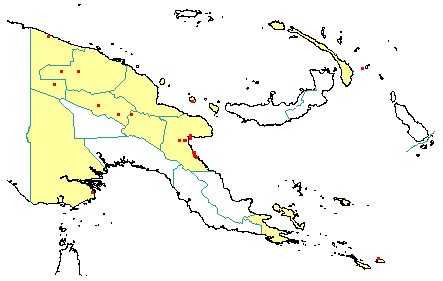
in PNGplants database
PNGTreesKey – Decaspermum bracteatum (Roxb.) Scott |
Barry Conn (NSW) & Kipiro Damas (LAE).
Guide to trees of Papua New Guinea
Copyright held by the authors, National Herbarium of New South Wales, and Papua New Guinea National Herbarium
Kew Bulletin Vol. 40 (1): 151 (1985)
Family: Myrtaceae
Dicotyledon
Timber Group: Occasional timber species
Field Characters: Small sub-canopy tree, occasionally Emergent tree, or Large canopy tree (30-50 m high); Bole cylindrical (30-50 cm diam.); straight (bole up to 35 m long); buttresses buttresses absent or buttresses present; spines spines absent; aerial roots aerial roots absent; stilt roots stilt roots absent; Bark brown (pale to dark), rough or smooth, scaly or flaky; Subrhytidome (under-bark) red; less than 25 mm thick, 3.0-5.0; bark blaze consisting of one layer; faintly to non-aromatic; outer blaze red, markings absent, fibrous; inner blaze red, markings absent, fibrous; bark exudate (sap) present (very slightly) or absent, colourless, not readily flowing (spotty), colour not changing on exposure to air, sticky; terminal buds not enclosed by leaves.
Indumentum: Complex hairs absent; stinging hairs absent; mature twig indumentum (hairs) absent.
Leaves: Leaves spaced along branches, opposite (in pairs, opposite one another on the branchlet), simple (a leaf composed of a single blade); petiole present, not winged, attached to base of leaf blade, not swollen; leaves sometimes broadest at or near middle or broadest below middle, 6.0-8.0 cm, 1.6-4.5 cm; symmetric, entire, not dissected or lobed, sub acute or long-tapering, venation pinnate, secondary veins open, not prominent, but visible, intramarginal veins absent; leaves lower surface pale green (glossy), upper surface green (glossy (to subglossy), indumentum (hairs) absent; absent; domatia absent; stipules absent.
Flowers: Inflorescence axillary, flowers on a branched axis, cones absent; flowers bisexual, stalked, flowers with many planes of symmetry, 5.0-10.0 mm long, diameter small (up to10 mm diam.) (8-10 mm diam.); perianth present, with distinct sepals and petals whorls, inner perianth white; 5, free; stamens 100, present, free of each other, free of the perianth; ovary inferior, carpels joined (when more than one), locules 5; styles solitary, 1.
Fruits: Infrutescence arranged on branched axis, fruit 5.0-6.0 mm long, 5.0-6.0 mm diam., brownish red or dark brown, not spiny, non-fleshy, simple, dehiscent, capsule; seeds 100, to about 5 mm long (4-5 mm long), not winged, narrow (longer than wide), seed 1-10 mm diam. (2-3 mm wide).
Distribution: West Sepik, East Sepik, Madang, Morobe, Western Highlands, Eastern Highlands, Western, Milne Bay, Papuan Islands & New Ireland.
 | Botanical records in PNGplants database |
Notes: Notes This species is morphologically, superficially similar to the Xanthomyrtus angustifolia - X. polyclada species group. However, the much larger and more branched inflorescence of Decaspermum bracteatum readily distinguishes it from the Xanthomyrtus species group, that characteristically has small, 3-flowered inflorescences.